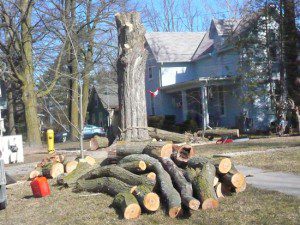
About a week ago, a friend up the street visited my next-door neighbour on a mission. With his pickup truck empty, save for his chainsaw and a can of gas, He began a day-long project dissecting the remains of a piece of history. A maple tree that had stood near the street at the corner of Ronnie Egan’s property for nearly a century had dropped too many dead or dying upper limbs to be safe anymore. So the township decided for the benefit of all concerned that the tree should come down.
“I cried the day they took it down,” Ronnie Egan admitted to me. “It was very sad to see it go.”
Ronnie remembered the first time she saw that maple. She had come to Uxbridge, Ont., from Halifax. As newlyweds during the Second World War – she as a chief petty officer in the Women’s Royal Canadian Naval Service, her husband Willis as a VIP chauffeur in the Canadian Army – the couple had come to Uxbridge on what was known as “compassionate leave.” When the war ended they would settle in that residential part of town. The maple was already a third of a century old when they arrived.
“It was maybe eight or 10 feet tall when we came home at the end of the War,” she said. “The trunk was maybe a few inches around.”
That was 1945, when the downtown boasted at least two hardware stores – one run by the Moore family, the other by the McEnany family – the dairy, a tannery, several shoe stores, Dominion Dry Goods, some drug stores, Montgomery woodworking store, some industrial businesses (manufacturing cement and cinder blocks) and the Brownscombe store that had a grocery department.
By the time Uxbridge Beverages began bottling Coca Cola, in 1948, couples in this community had begun raising the children of the baby boom. No doubt that street-side maple tree – nearing 50 years of age – had become the perch for many a climbing kid or a silent partner in skip-rope when the game was short one rope-holder.
Once, one of Ronnie’s neighbours suggested the maple was in the way and should be cut down.
“Over my dead body,” Ronnie protested. And the maple remained.
Sometime later, in the 1970s and ’80s (when our family arrived next-door to the Egans) I learned what a gift, saving that tree had been. When we came to town in 1988, I remember the welcoming sight of a street dotted with older homes that were all guarded by a row of maple sentinels.
That maple on Ronnie’s property line and the others lining our street provided an all-weather, all-season canopy, shading our homes from the intensity of the mid-summer sunshine and then providing a windbreak during the wildest storms of the winter. The maple may have made us work extra hard each autumn raking up its characteristically large golden leaves, but the labour was worth the protection the tree offered through nature’s seasonal extremes.

And if that tree could talk, the stories it could tell – of the politicians who’ve come and gone, of the evolution from county to regional municipality, of the commercial struggle between downtown merchants and edge-of-town chain stores, of the evolution and revolution from twice-a-day trains to automobiles, highways and GO Trains, and of the rise and fall of weekly newspaper enterprises in the community.
The day Uxbridge Tree Service came with its chainsaws, block and tackle, wood chipper and hydraulic cherry-picker box, a number of us watched as the handful of crew set up protective cones on the street and began to bring the maple down. As the upper limbs fell to the ground, the midday sun broke through. As the main trunk tumbled like broken building blocks across the lawn, scores of inner rings revealed the maple’s age – well over a hundred of them.
But the heart of the cut tree revealed more than its age. Among its growth rings was a chunk of wire, apparently a piece of fencing absorbed by the trunk perhaps half a century ago. Nature had overcome progress then. Now progress had evened the score.

Before my friend up the street took away the fruits of his all-day labour – cutting the fallen slabs of maple into pieces small enough to put in his fireplace sometime next winter – Ronnie asked for a couple of mementos. Since she had a greater attachment to that tree than of any of us, we obliged and put a large cross-section of the maple on her veranda.
“The view is different from here now,” she said. “There’s more sun coming through than I need. But one of the pieces of the maple makes a beautiful table. It reminds me of what was there all those years.”